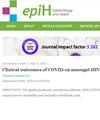Limiting the spillover of zoonotic pathogens from traditional food markets in developing countries and a new market design for risk-proofing
IF 2.2
4区 医学
Q2 PUBLIC, ENVIRONMENTAL & OCCUPATIONAL HEALTH
引用次数: 0
Abstract
Traditional food markets are age-old systems that primarily serve the food supply needs of society's less affluent sectors, often operating with minimal infrastructure. These markets are prevalent in low and middle-income countries. However, their hygienic conditions are frequently suboptimal, potentially fostering the emergence and spread of putative zoonotic diseases. The recent emergence of zoonotic or potentially zoonotic diseases and their possible links to traditional food markets underscore the need for focused attention on this overlooked issue. The socio-economic characteristics of traditional food markets reveal that despite the risk of zoonotic pathogen spread, these markets play a crucial role for large segments of the population. These individuals rely on such markets for their livelihood, food, and nutrition. Therefore, a comprehensive set of measures addressing various aspects of traditional food markets is necessary to manage and mitigate the risks of potential zoonotic disease emergence. In this article, we explore various facets of traditional food markets, paying special attention to the risks of zoonotic diseases that urgently require stakeholder attention. We also propose a new market design to prevent the risk of zoonotic spillover and advocate for the development of a Market Hygiene Index (MHI) for these markets.限制发展中国家传统食品市场的人畜共患病原体外溢,并为防范风险设计新的市场
本文章由计算机程序翻译,如有差异,请以英文原文为准。
求助全文
约1分钟内获得全文
求助全文
来源期刊

Epidemiology and Health
PUBLIC, ENVIRONMENTAL & OCCUPATIONAL HEALTH-
CiteScore
6.30
自引率
2.60%
发文量
106
审稿时长
4 weeks
期刊介绍:
Epidemiology and Health (epiH) is an electronic journal publishing papers in all areas of epidemiology and public health. It is indexed on PubMed Central and the scope is wide-ranging: including descriptive, analytical and molecular epidemiology; primary preventive measures; screening approaches and secondary prevention; clinical epidemiology; and all aspects of communicable and non-communicable diseases prevention. The epiH publishes original research, and also welcomes review articles and meta-analyses, cohort profiles and data profiles, epidemic and case investigations, descriptions and applications of new methods, and discussions of research theory or public health policy. We give special consideration to papers from developing countries.
 求助内容:
求助内容: 应助结果提醒方式:
应助结果提醒方式:


